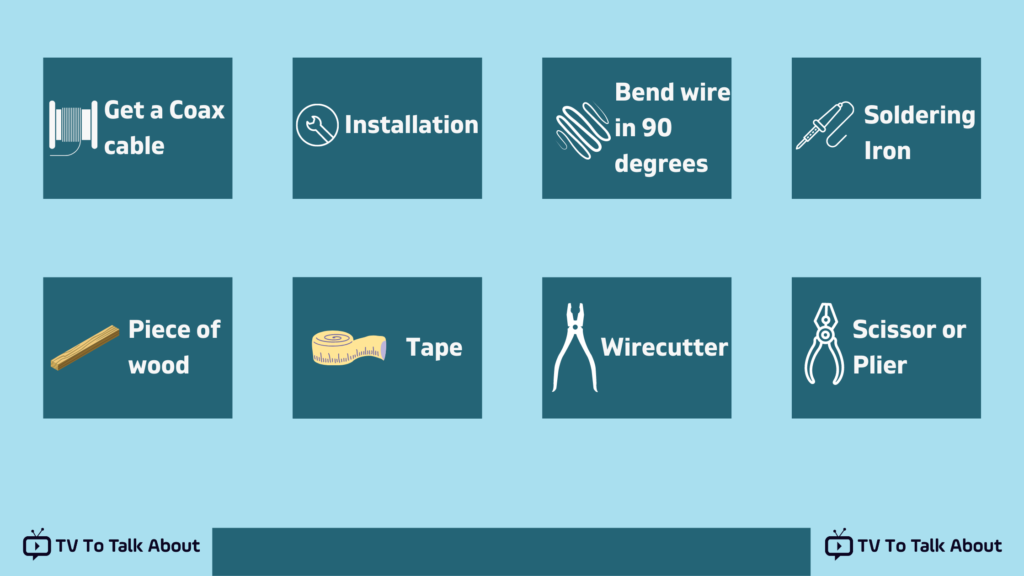Typically, all TV sets come with an antenna. The antenna enables and sends signals to the TV, making whatever you are watching clear and enjoyable. Sometimes, these antennas can get glitchy, making you lose signals while watching TV. Also, the antenna can be broken and will need to get repaired.
Luckily, you can use easy DIY (Do It Yourself) hacks to get yourself another antenna using available materials at home. Using a coaxial cable is an alternative way to make a TV antenna.
What is a Coaxial Cable?

A coaxial cable is a transmission line prominent amongst cable operators, tech companies, internet providers, etc., to transmit data signals. This cable consists of an inner conductor enclosed by a circular conducting shield. Coaxial cable is also used in the house; it is reliable and transmits data accurately.
One of the most prominent coaxial cable features is its shielded design, allowing the swift transmission of data. There are three primary coaxial cable sizes; the RG-6, RG-11, and RG-59.
Components of a Coaxial Cable
Coaxial cables are quite popular due to their shielded design, allowing swift data transmission while protecting the cable from interference and damage. In addition, it reduces electromagnetic interference (EMI).
Coaxial cables are built on different components, they are:
- A centre conductor: usually a copper wire that helps with the transmission of data
- First layer: made from Dielectric plastic insulator
- Braided mesh: made from copper also; it shields the cable from electromagnetic interference (EMI).
- External layer: made from the plastic coating, it protects the internal layers from damages.
Pros of Coaxial Cable
- Durable
- Up to 10Mbps capacity
- Affordable
- Easy to install
- Excellent resistance to EMI
- Easy to wire and expand
Cons of Coaxial Cable
- Cable failure can bring down the network
How to Make TV Antenna from Coaxial Cable

The materials you will need to make a TV antenna from a coaxial cable include a coax cable, wood, tape measure, soldering, iron, and wire cutter. Below is a guide on how to make a TV antenna from coaxial cable:
Get a Coax cable
Coax cable is similar to the cable used in connecting your cable box to your TV. The cable should be long enough to run from the back of the TV up to the wall where you will be mounting the antenna.
Piece of wood
Get a short piece of wood that will be enough to hang the coax cable onto. It can be a wooden skewer, chopstick, dowel, etc.
Tape
The tape measure is to get the cable’s exact inches, length, and diameter.
Wirecutter
Use the wire cutter to cut the coax cable on one side. This is to remove one of the connectors. The other connector will be used to connect the cable back to the TV. You can use a utility knife or scissors to remove carefully any outer jacket from the cable. Remember not to cut into the shield.
Scissor or Plier
Use a scissor or plier to unbraid the shield on the cable back to where it exits the jacket. Then, twist the braid together and bend at a 90-degree angle to the coax cable.
Soldering Iron
Use a soldering iron to solder the braid together carefully. Ensure you smoothen all edges together without using the soldering iron to melt the inner insulator. Remove some inches from the inner insulator and leave some inches between the center wire and the shield.
The inches you should remove and leave depend on the insulator’s length and depth. For instance, suppose the inner insulator is about 5 inches and a half; you are to remove about 5 inches and leave about half-inch to insulate.
Bend wire in 90 degrees
Proceed to bend the center wire in the opposite direction of the braided wire. Then tape the two wires that are the center wire and soldered shield to the wooden dowel,
Tape the two wires (center wire and soldered shield) to the wooden skewer, chopstick, dowel or whatever you want to use to host the cable.
Installation
Install a wooden dowel carrying the antenna and attach it to the wall. You can hang it anywhere that is convenient in the house to the TV. Proceed to connect the opposite end of the cable to the T’s coax video input.
Initiate turning on your TV to capture the HDTV channels in your area. Rehost or change the location of the antenna if you are not getting maximum channels.
Conclusion
Making antennas is hassle-free; it is fun, inexpensive, and easy to make. The materials needed can be gotten easily, so you do not have to contact an installer or technician to get them done.
Aside from making an antenna from a coaxial cable, you can also make an antenna from paper clips, hangers, cards, and foils.

